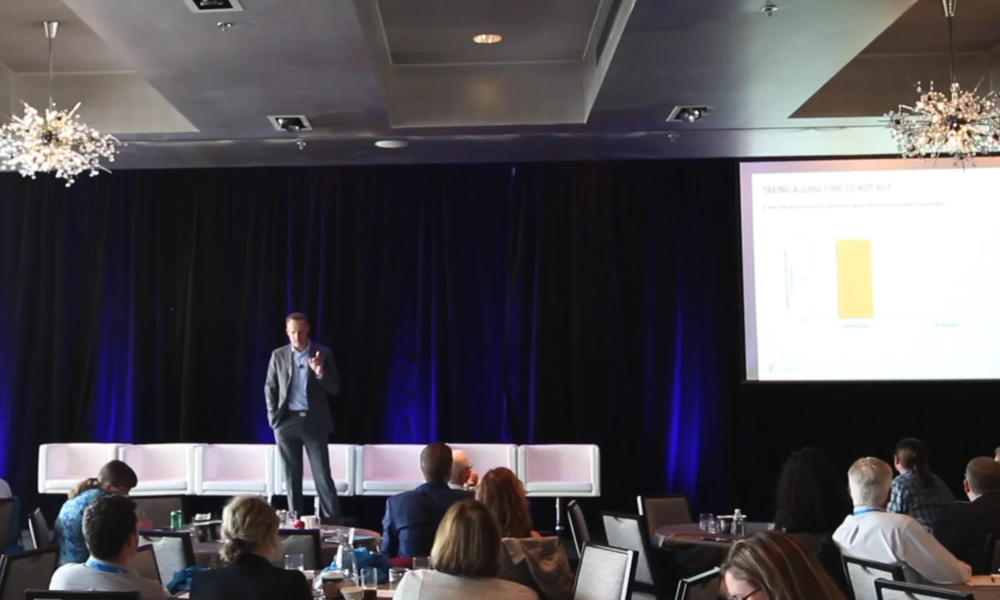Maximizing Seller Capability to Engage Modern Customers
4K Views | 12 Min Read
Today’s sellers must be capable of breaking down the customer’s status quo.
To convince buyers that change is needed, sellers need the skills to deliver unique insights that appeal to both buyers’ rational and emotional senses. This means that salespeople do not just need to know what to say, they need to know how to deliver the message in an effective way. By nurturing the characteristics and behaviors that make salespeople productive and combining that with impactful messaging, sales enablement practitioners can increase salespeople’s capability to bring true value to buyers.
As the market landscape and buying processes continue to increase in complexity, companies need to dig deep into the capabilities of their sales teams to ensure they connect effectively with buyers. This begins with understanding exactly what is changing in the customer’s world and why.
How is the Landscape Changing?
1. Number of stakeholders involved in a purchase decision
As more people are involved in evaluating a purchase, the chance this ‘buying group’ comes to consensus and makes a decision to buy declines significantly. When just one individual bears the responsibility, he or she has an 81% likelihood of taking action. However, this likelihood drops to 55% with the addition of a second buying group member due to the increased probability of clashing opinions and friction slowing the process. The trend continues as more buyers become involved; with six stakeholders, odds of a favorable decision drop to just 31%.
When paired with the fact that the number of stakeholders involved in a purchase decision is also steadily on the rise, sellers must learn to effectively engage the entire buying group – especially as these trends show no sign of slowing.
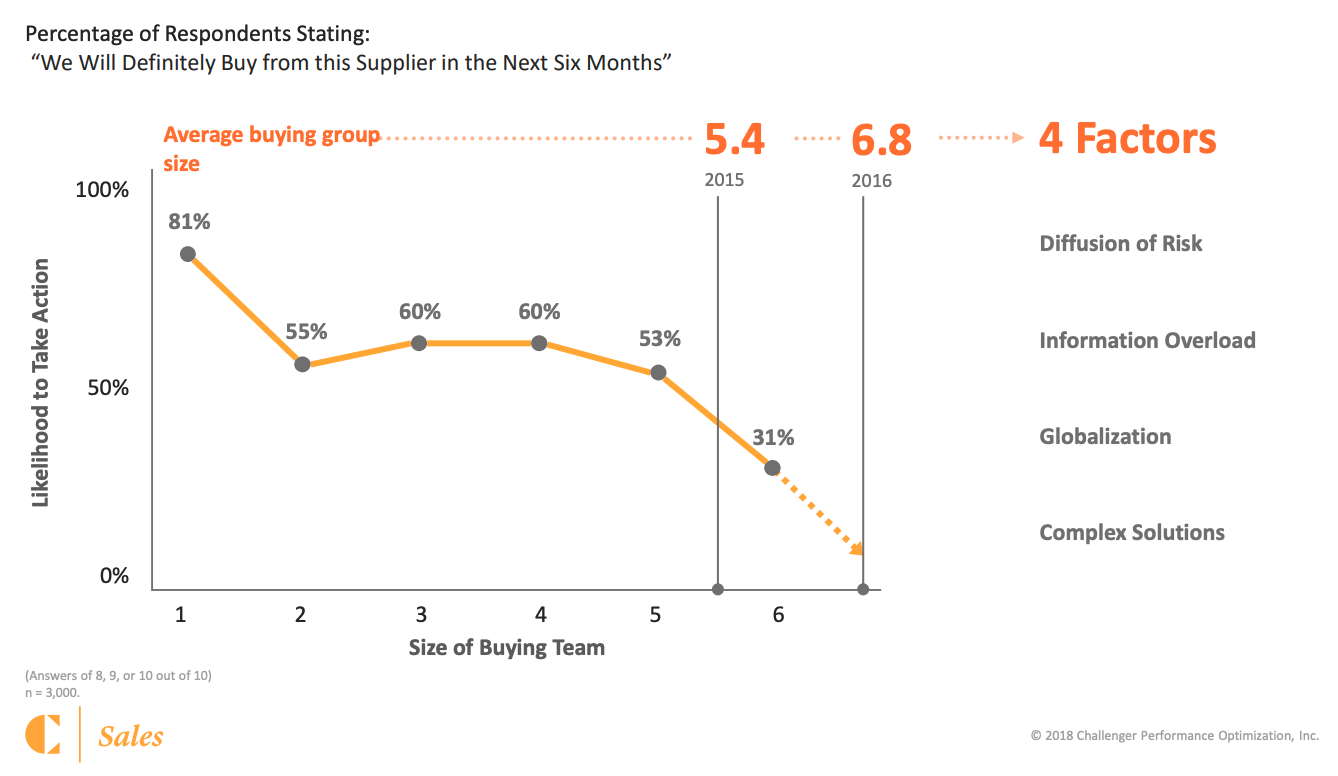
The average number of stakeholders involved in complex B2B decisions rose from 5.4 in 2015 to 6.8 in 2016. This year, that number leaped to 10.2 individuals. Such massive changes in buying group dynamics can dramatically affect the likelihood of sellers being able to close business. There are a few factors that influence the complexity of large groups in evaluations:
- Diffusion of risk: Organizations are typically risk-averse, so individuals want to push risk to as many stakeholders from as many departments as possible. Rather than make a decision alone, they can share the blame if the risk proves unsuccessful.
- Information overload: A single individual could never feasibly process all the information out there about solutions and come to an informed decision from it. They need more people involved to help digest information.
- Globalization: As companies grow, the important teams and stakeholders in an organization that need to be involved in decision-making spread further across the globe.
- Complex solutions: Solutions increasingly integrate into more aspects of the business, which warrants the involvement of more stakeholders representing diverse perspectives and departments in the decision-making process.
2. The time it takes buyers to decide
As complexity in buying processes increase, sales cycles are stretching, with the average lasting 4.9 months. This length may not seem surprising for a complex B2B buying decision and the distribution around this mean is likely significant. What is concerning, however, is that it takes nearly as long for buyers to come to no decision, or 4.7 months on average.
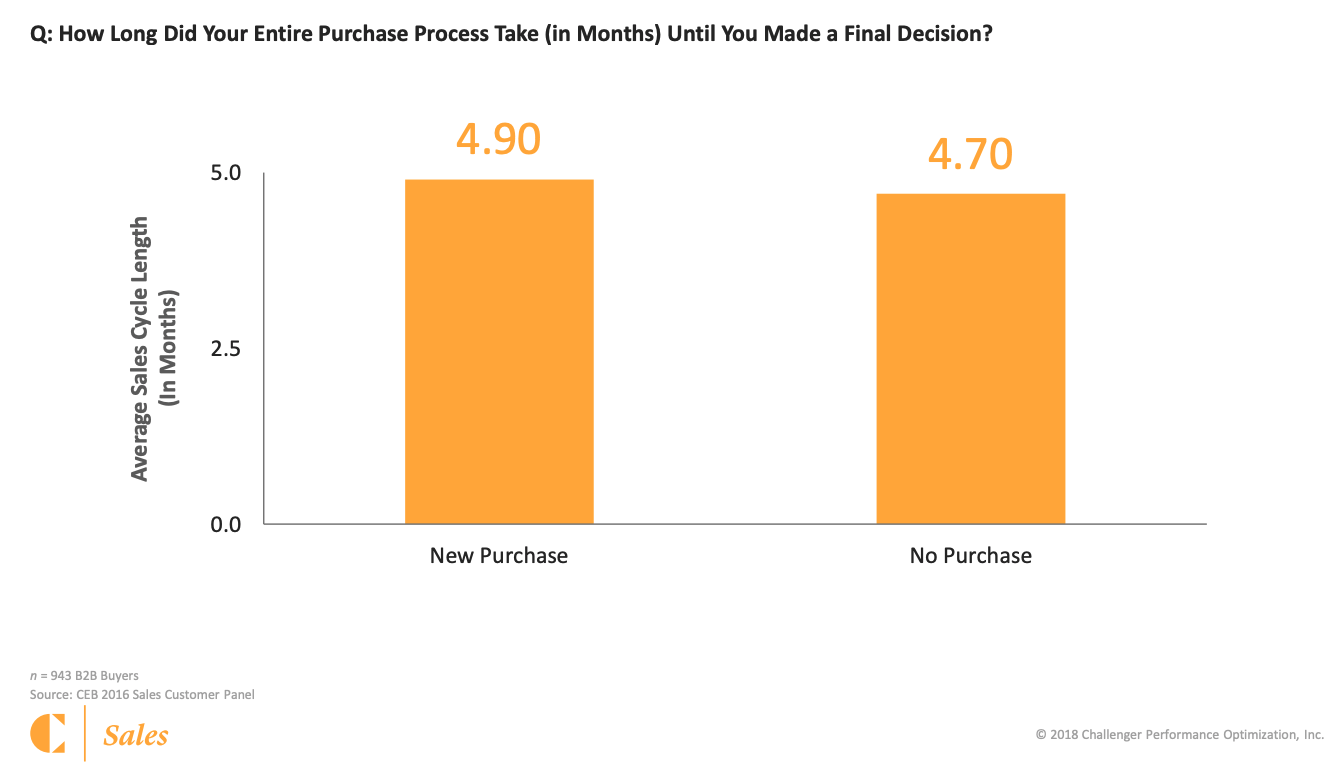
Where there has historically been a wedge in the sales funnel – a steady decrease in the number of deals moving forward or out over time – there is now an upside-down obelisk. This means that almost every opportunity moves forward in the funnel until the end when only a few become closed-won.
It is tremendously wasteful to have salespeople spend four months in all kinds of meetings, negotiations, demonstrations, and presentations for only a small percentage of those deals to close in a win. Modern sales teams must address the fact that it takes just as long to not buy as it takes to buy.
3. The influence of buying experience in purchase decisions
Looking beyond whether the seller closes a deal, it is equally important to measure the impression that the seller left on the customer. No matter the quality of the solution, if a buyer has a negative experience with a seller, it can lead to regret and lack of trust in the supplier. Ultimately, this makes it more difficult to upsell, cross-sell, or retain existing customers. While also having the potential to lead to the spread of negative word-of-mouth that can have a domino effect on other buyer relationships.
In fact, there is a near-linear correlation between the degree of purchase regret and whether a buyer found the purchase experience overwhelming or difficult.
With increasingly complex B2B purchase decisions leading to a higher likelihood of buyer’s remorse, it is imperative that salespeople are equipped to manage relationships with customers throughout the entire buyer’s journey.
How Can Sales Enablement Help?
1. Resist the status quo
When salespeople are not producing expected results, there are three common approaches sales enablement practitioners take to implement solutions: push sales process adherence, increase lead activity, or pivot around the solution they are selling.
However, these default options don’t yield better performance. Adherence might perpetuate a flawed system; increasing lead activity ignores the holes in the pipeline that contribute to low conversion rates; and pivoting the product is too time-intensive and costly.
Instead, sales enablement professionals should focus first on sellers bringing the right message that properly and effectively engages the customer with disruptive commercial insight – and ensure sellers are capable of delivering this message in a powerful and convincing way. Only after securing these foundations can the message be scaled through adherence to an effective process. In doing so, sellers are more than twice as likely to be high performers.
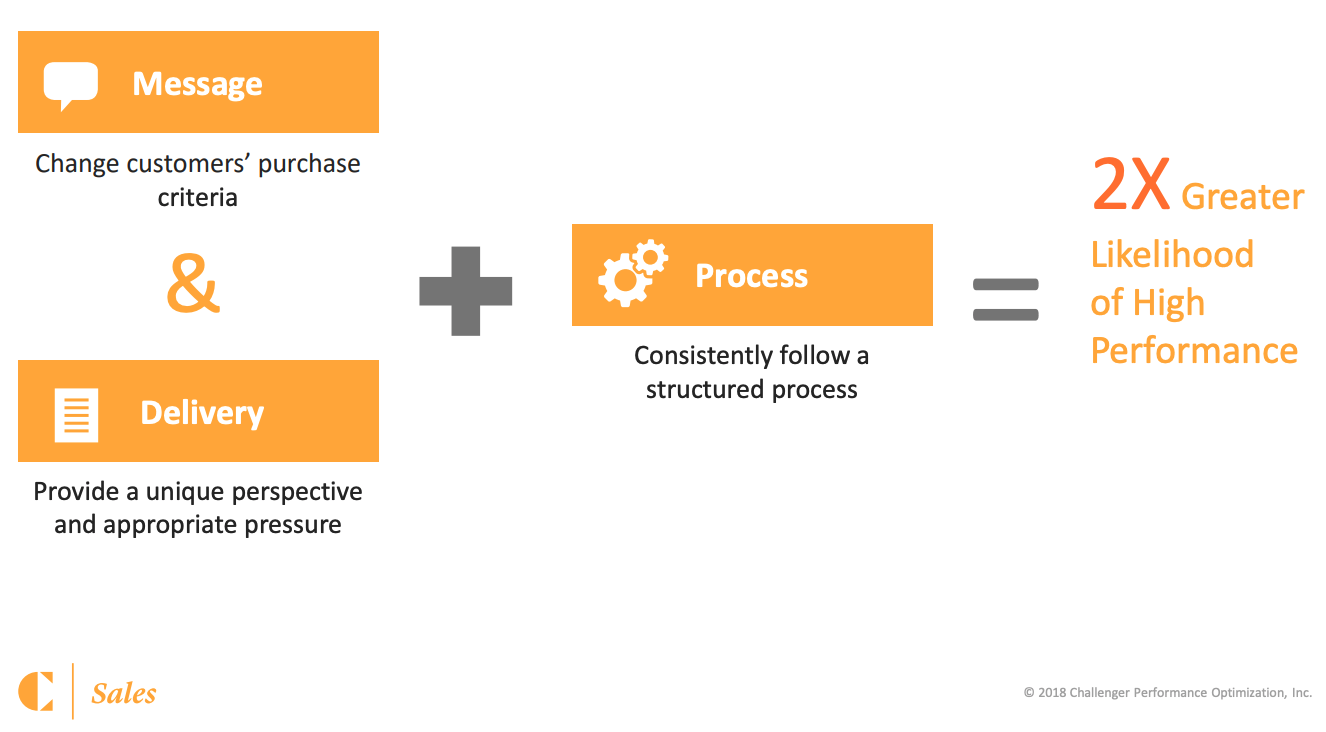
2. Assess and refine the message
An effective message contains elements that will drive or change a buyer’s direction. What can break down their status quo and challenge them to act differently?
First, there are many common messaging trends that are insignificant drivers of customer behavior and provide little-to-no differentiation from industry competitors. For example, such elements include expert perspectives, simplistic content, interesting facts or anecdotes, and easily accessible messaging.
While these are still useful techniques, most companies already do this with their messaging, and they won’t necessarily compel someone to buy on their own. To stand out from the crowd, organizations need to focus on providing tangible value to buyers through messaging. Consider whether the message does the following:
- Teaches the customer something new by presenting information they might not have considered about their businesses
- Brings a compelling reason toward action
- Breaks down what is missing or wrong in their status quo to guide them in a different direction, toward the solution
Impactful content challenges assumptions, catalyzes action, and leads to — not with– an organization’s unique strengths.
3. Deliver the message to customers in an effective way
Simply refining the message is not enough to drive meaningful change – it also requires effective delivery. In the same way that a good movie will take the audience on an emotional journey, an effective sales pitch should be thought of as a performance that appeals to buyers’ emotions and motivates them to make a change. This choreography can be simply explained in three steps:
- The warm-up: Early in the conversation, establish credibility by providing the top-level reasons for the customer to listen and fundamentally think differently about their situation.
- The show: Demonstrate why the pain of same is greater than the pain of change through rational explanation: facts, statistics, and calculations.
- The finale: Pinpoint the anecdotes that appeal to their emotions to make it real for them, make it personal, and ultimately lead them forward in a consultative new direction.
4. Scale it through processes and embed it in the culture
Behind this delivery are four categories of characteristics at the core of all salespeople: gifts, graces, chores, and skills.
- Gifts are beneficial things that high performers do naturally, such as discretionary effort, incentive motivation, or maintaining enduring customer relationships. These tendencies are organic and can be hired for.
- Graces are common-sense behaviors that everyone should be doing, such as being kind and accommodating. While these don’t play a direct role in high performance, they should be central to a positive sales culture.
- Chores are necessary, yet unpleasant things that don’t make significant performance difference, like time spent prospecting. Such habits can’t truly be improved in quality but can be made more efficient and less burdensome for salespeople.
- Skills are hard, yet crucial things that come less naturally to salespeople, like pressuring customers in appropriate moments or offering unique perspectives. These skills make high performers.
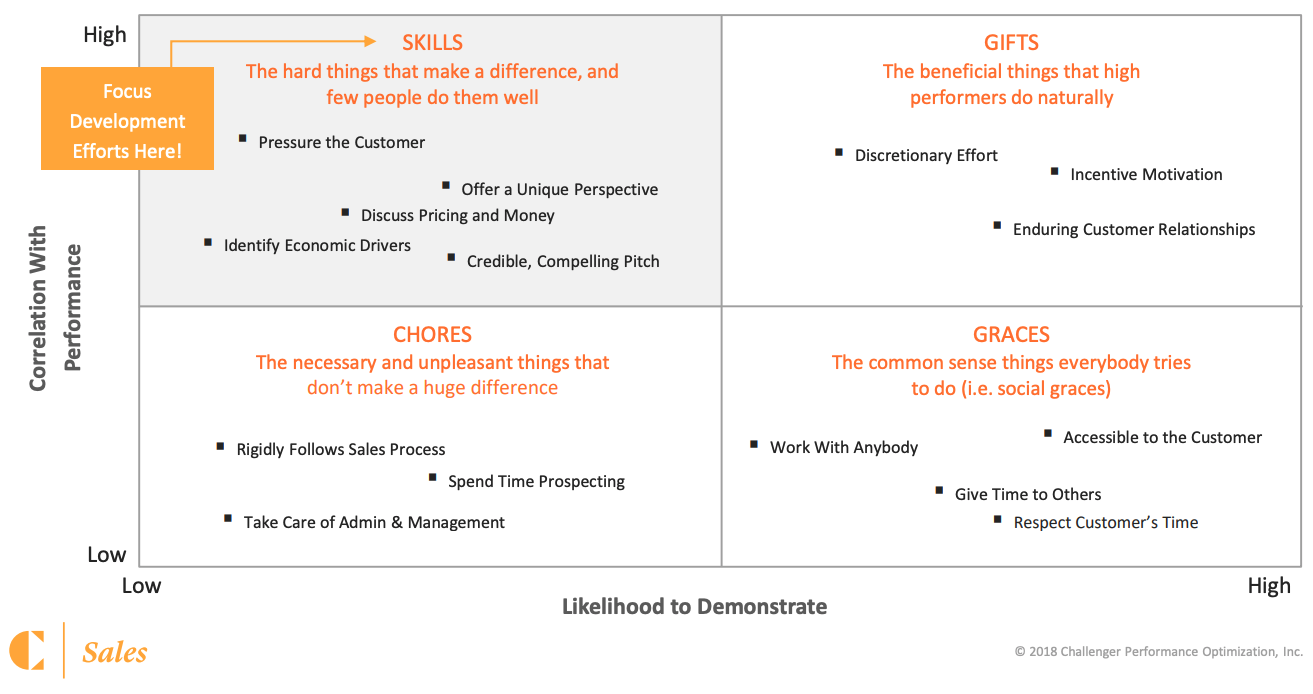
All salespeople will tend to lean on different combinations of these characteristics. Commonly, sales teams have a mix of the following types of combinations:
- The Relationship Builder: who relies on social graces to build and maintain customer relationships.
- The Hard Worker: who does all the chores by focusing on the administrative work, planning, and doing what they can.
- The Problem Solver: who executes on any of the four categories to solve any immediate customer problems.
- The Lone Wolf: who balances gifts and skills by following their instincts and doing their own thing.
- The Challenger: who develops capability in the skills many run away from, like successfully bringing a unique perspective, creating constructive tension, teaching for differentiation, tailoring for resonance, and taking control.
To truly scale the delivery of a message throughout the sales process, sales enablement needs to plant a healthy balance of these characteristics within the sales culture. This means paying more attention to the gifts and graces a company wants to hire for, spending less time training around chores and instead building efficient processes, and increasing efforts to up-skill sellers to effectively deliver the right messages.
By ingraining these skills in the culture and sales process, salespeople will be equipped to effectively engage modern buyers.





